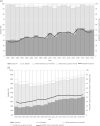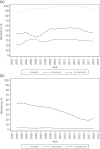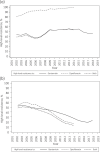Replacement of Enterococcus faecalis by Enterococcus faecium as the predominant enterococcus in UK bacteraemias
- PMID: 34909690
- PMCID: PMC8664539
- DOI: 10.1093/jacamr/dlab185
Replacement of Enterococcus faecalis by Enterococcus faecium as the predominant enterococcus in UK bacteraemias
Abstract
Objectives: To review temporal changes in the proportions of different Enterococcus species recorded in two UK bacteraemia surveillance systems. Antibiotic resistance trends were also considered.
Methods: We reviewed data for enterococci from 2001 to 2019 in: (a) the BSAC Resistance Surveillance Programme, which collected up to 7-10 bloodstream enterococci every year from each of 23-39 hospitals in the UK and Ireland and tested these centrally; and (b) PHE bacteraemia surveillance, using routine results from NHS microbiology laboratories in England.
Results: BSAC surveillance, based upon 206-255 enterococci each year (4486 in total), indicated that the proportion of Enterococcus faecium rose from 31% (212/692) in the period 2001-3 to 51% (354/696) in the period 2017-19, balanced by corresponding falls in the proportion of Enterococcus faecalis. PHE surveillance provided a larger dataset, with >5000 enterococcus reports per year; although its identifications are less precise, it too indicated a rise in the proportion of E. faecium. BSAC surveillance for E. faecium indicated no consistent trends in resistance to ampicillin (≥86% in all years), vancomycin (annual rates 19%-40%) or high-level resistance to gentamicin (31%-59%). Resistance to vancomycin remained <4% in E. faecalis in all years, whilst high-level resistance to gentamicin fell, perhaps partly reflecting the decline of two initially prevalent gentamicin- and ciprofloxacin-resistant clones.
Conclusions: Both surveillance systems indicate a growing proportion of E. faecium in enterococcal bloodstream infections. This is important because fewer therapeutic options remain against this frequently multiresistant species than against E. faecalis.
© The Author(s) 2021. Published by Oxford University Press on behalf of the British Society for Antimicrobial Chemotherapy.
Figures



References
-
- Billington EO, Phang SH, Gregson DB. et al. Incidence, risk factors, and outcomes for Enterococcus spp. blood stream infections: a population-based study. Int J Infect Dis 2014; 26: 76–82. - PubMed
-
- Reynolds R, Hope R, Williams L.. Survey, laboratory and statistical methods for the BSAC Resistance Surveillance Programmes. J Antimicrob Chemother 2008; 62: ii15–28. - PubMed
LinkOut - more resources
Full Text Sources
